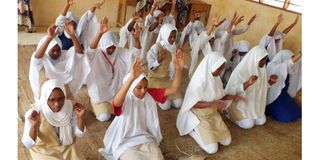How devolution has enhanced girls’ access to education

Students of Bright Girls Secondary School in Shela Lamu County attend a Yoga session in this photo taken on March 13, 2014. A new study reveals that the county has received the largest education fund since the onset of devolution.
What you need to know:
- A report on The Assessment of the Impact of Devolution on Women and Girls by a multi-agency team says devolution has significantly increased women and girls’ access to education.
- The study was conducted across 14 counties including Busia, Garissa, Isiolo, Kajiado, Kilifi, Lamu, Mandera, Narok, Samburu, Tana River, Turkana, Wajir and West Pokot.
- Lamu County started with 150 ECD centres, but now boasts 203 facilities and more than 13,000 pupil enrolment.
Devolution has significantly increased women and girls’ access to education, a study reveals.
A multi-agency team comprising the Council of Governors, the State Departments of Gender and Devolution, Kenya National Bureau of Statistics (Kebs), University of Nairobi Gender Studies Department and the National Gender and Equality Commission (NGEC) last Friday launched a report on The Assessment of the Impact of Devolution on Women and Girls in Nairobi.
The study conducted an in-depth gendered analysis of the effectiveness of devolution in five sectors across 14 counties including Busia, Garissa, Isiolo, Kajiado, Kilifi, Lamu, Mandera, Narok, Samburu, Tana River, Turkana, Wajir and West Pokot.
At the onset of devolution in 2013, 47 devolved units of government were created under the Intergovernmental Relations Act. Among other objectives, county governments are mandated to promote and protect marginalised groups of people including women and girls.
Sanitary towels
Speaking at the launch, Council of Governors Chief Executive Officer, Mary Awiti, said the report findings proved that indeed ‘devolution is working’.
The study shows that the number of girls enrolled in pre-primary school increased by 15.2 per cent since 2013 (when devolution began). Additionally, the cumulative number of early learning institutions across the 14 counties is 6,512 with more than 1.4 million girls enrolled in early childhood development centres (ECDC).
It identifies a number of factors that have contributed to the tremendous growth in girls’ access to education, noting that most counties increased their investment in education infrastructure, introduced scholarships that favoured affirmative action, and provided sanitary towels to school going girls.
“The morale of pupils is high as interventions to keep them in school when faced with unpredictable circumstances are consistent and predictable including school feeding programmes, availing learning materials and aids and also playing equipment,’’ part of the report reads.
Deserving students
Lamu County is reported to have the largest education fund since the onset of devolution, with more than Sh250 million in scholarships and bursaries every financial year. The fund has assisted more than 7,000 deserving students, 80 per cent being girls, through high school, college and universities.
The county started with 150 ECD centres, but now boasts 203 facilities and more than 13,000 pupil enrolment.
Similarly in Mandera County, women and girls have benefitted from the Mandera Girl Child Education Affirmative Action Programme, which sponsors top female students to Turkey to study courses that are traditionally male-dominated. The fund has disbursed more than Sh440 million in the last five years in a conscious commitment to ensure access to education for girls.
Prior to devolution, only 22 per cent of women in Mandera had received any education at all. Additionally, the county only had four ECDE teachers employed by the former Mandera County Council.
Despite strong patriarchal beliefs amongst the dominant Pokot and minority Sengwer community in West Pokot County, girls make up 48.4 per cent of the 73,475 ECDC enrolment, while more than 60 per cent of the teachers are women.
Patriarchal norms
The county bursary program employs the gender rule in provision of scholarships and bursaries, while single mothers are supported to cater for their children's education.
In Wajir County, however, retrogressive cultural practices and deeply entrenched patriarchal norms have caused huge gender disparities at basic education level.
More than 60 per cent of primary school-going children are boys, while only 32 per cent are girls. At secondary school level, girls make up 26 per cent while boys make up 74 per cent. This disparity has also been attributed to female-genital mutilation and early marriages.
The rest of the counties (Busia, Garissa, Isiolo, Kajiado, Kilifi, Narok, Samburu, Tana River, Turkana and Wajir) have recorded steady increase in girls’ school enrolment and retention.





